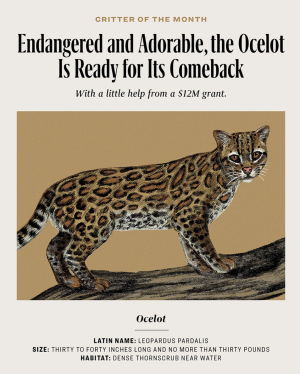
The Lovable Ocelot Is Ready for Its Comeback

Latin Name: Leopardus pardalis
Size: Thirty to forty inches long and no more than thirty pounds
Habitat: Dense thornscrub near water
The ghost cat pads through the brush on silent, velvety paws. Creeping nimbly under low-lying branches, it uses highly evolved night vision to zero in on prey. A sudden flash of golden brown eyes is swiftly followed by the swipe of razor-sharp claws, a hiss, and a fatal pounce upon an unlucky mouse or rabbit. Then the cat vanishes into the night, where it’s always watching but rarely seen. We’re talking, of course, about what may be Texas’s most elusive and beautiful creature: the ocelot, a small but powerful wildcat that has captivated humans for millennia. It frequently appears in ancient Mesoamerican art, and Salvador Dalí kept one as a pet. Today very few remain here, but that could soon start to change.
How many are left?
Estimates hover at eighty to a hundred ocelots in the state, “but we don’t have confidence in that,” says Lisanne Petracca, a carnivore ecologist at a carnivore ecologist at the Caesar Kleberg Wildlife Research Institute at Texas A&M University–Kingsville. Ocelots thrive across much of Central and South America and parts of Mexico; in the U.S. they’re found only in the Lower Rio Grande Valley, where two populations remain: one centered at El Sauz Ranch and another at Laguna Atascosa National Wildlife Refuge. To get a more accurate count, Petracca and her team are using game cameras to record the unique rosette pattern in each cat’s fur and will soon deploy scat dogs trained to sniff out ocelot poop.
Why are ocelots so endangered?
They once roamed much of Texas, but hunting and habitat loss drove them to the brink more than fifty years ago. They’re picky about their environment: only dense Tamaulipan thornscrub will do. Cars pose another threat. A 2021 study found that 40 percent of deaths of radio-collared ocelots involved vehicles. Researchers hope to introduce a third population in an area far from busy roads.
How will that work?
It’s very cool! Scientists plan to use artificial insemination, thanks in part to a
$12.2 million federal grant. Semen from males, who are captured and released, will be used to impregnate females in zoos, and the second generation of offspring will be set free. Petracca and her colleagues will open a Kingsville lab for this work, tentatively called the Ocelot Conservation Facility. They hope to break ground this year and release the first ocelots
in 2025 or 2026.
How do ocelots reproduce anyway?
Males (sometimes called torns) compete for the ladies, or “queens.” “You’ll often see, especially on an older male, scars on their face indicating that they have been in battle for territories or females,” Petracca says. Researchers don’t know for sure, but they believe that ocelots breed year-round, and a litter is usually one or two kittens. The kittens are born with blue
eyes that later turn brown. Ocelot moms protect the kittens from predators and begin teaching them how to hunt when they’re just four to six weeks old. You’ve gotta learn fast when you’re a wildcat.
This article originally appeared in the March 2024 issue of Texas Monthly with the title “Ocelot.”